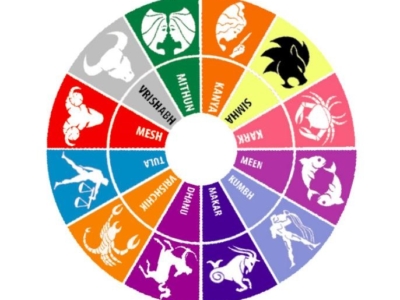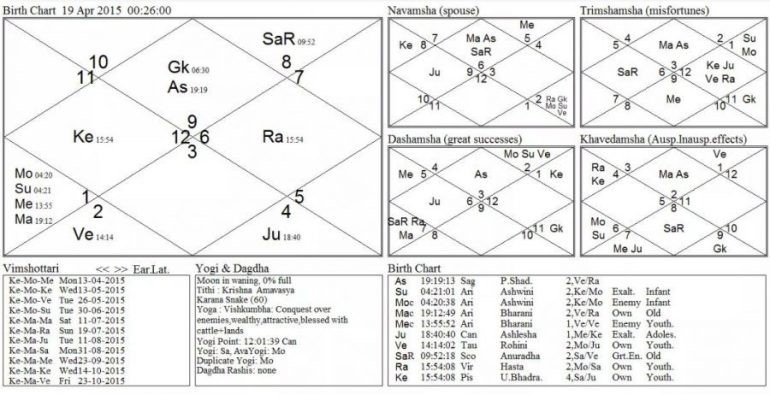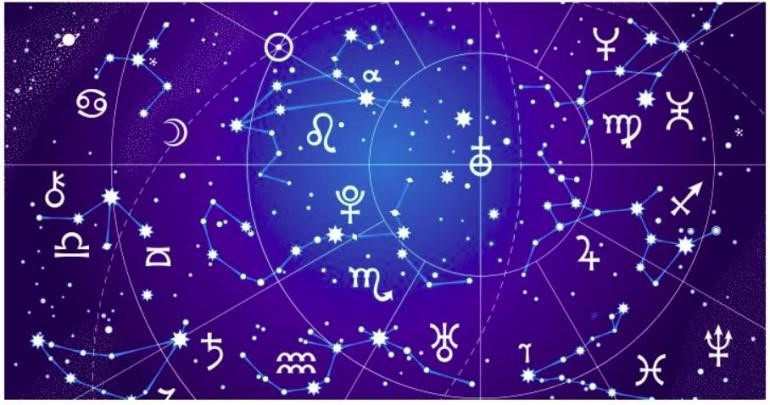Jyotish Shastra, also known as Hindu Astrology or Vedic Astrology, it is a divine knowledge on knowing future. With its help, a man can foresee the good and bad events that are going to happen in his life. There are various elements that affect the system of Jyotisha in many ways. All elements of Vedic astrology have its own significance in predicting one’s future.
Basic Elements of Vedic Astrology
Gocharas – The Transits
Gochara is the study of planetary movement from the Natal moon (Moon placement in our Birth chart). Natal Moon is taken as the starting point for the transiting planets. In predicting Gochara results, the moon plays a prominent role. The zodiac sign in which your natal moon is placed is known as Janma Rashi (Birth Sign).Though the planetary positions in our horoscope are fixed, the planets continue to move. Planets take varying periods to move from one Rashi to another Rashi.

Rashis – Signs Of The Zodiac
Rashis (The Zodiacs) shows the constellation in which the Sun is located at the time of our birth. The zodiac is a twelve-fold division of the Sun’s apparent path along the ecliptic.Twelve segments of the sky have been given names and certain constellations associated with each.
Such as:

- Tula (Libra – Scales of balance)
- Vrishchika (Scorpio – Cavity or hiding place)
- Dhanusha (Sagittarius – The transformation of the beast into human being)
- Makara (Capricorn – Involvement of the individual in the process of the universalization of human energy)
- Kumbha (Aquarius – The water bearer and the water flowing from a pitcher)
- Meena (Pisces – Two Fish)

Kundali – The Natal Chart
Kundali is a map representing the positions of the Sun, Moon, planets and astrological aspects at the time of an event. Basically, it is defined as a map of the sky and the planets typically the moment of a person’s birth. Hence, it is also known as the Birth Chart.
There are many methods of charting the twelve houses. Some are circular, some rectangular, some box-like formations, and others in geometrical form, but they all represent the 360° of the celestial horizon.
Bhavas – The Houses
On a Kundali, the astrologers draw the physical-astronomical diagram and enter into the realm of spiritual forces in order to predict the effect of the various forces impinging upon the individual which is known as Bhavas.
The Vedic system of astrology consists of twelve houses and each house has its own allegation, own meanings, and values. It is also about understanding major happenings in your life.

So every house affects many parts of one’s life and each house is divided into many Nakshatras. This is one of the reasons kundali matching for marriage is advised by the astrologers.

Nakshatras – The Lunar Mansions
The Nakshatras are the central axes around which Hindu astrology rotates. There are twenty-eight Nakshatras forming the circle of 360°. These lunar mansions should be carefully studied to predict the future of an individual. The Moon has a special relationship with the Nakshatras which alters the character of a horoscope. The very nature of the Moon is different in different Nakshatras.
The three Gunas — Sattwa, Rajas, and Tamas — also affect each Nakshatra differently. The Nakshatras are also categorized according to the four basic motivations of a human being, Artha (meaningful action), Karma (passional action), Dharma (righteous action), and Moksha (liberation, karma-less action).
Grahas – The Planets
As per Jyotisha Shashtra (also known as Vedic Astrology), there are nine planets having their particular function in the natal chart and represent special energies. These nine planets are collectively known as “Navagrahas“. Effects of these planets are influenced by the zodiac sign it occupies.
There are Nava Grahas (nine planets) in the Jyotish Shastra and they include:

Standing in the center facing east in the company of the other planets, Surya is the Sun-god also called Ravi and he is considered the lord of the planets (Grahapati). He rides a one-wheeled chariot pulled by seven horses representing the seven colors of the white light and seven days of the week. The day of Sun is Sunday and the gemstone is Ruby. The ill placement of the Sun in the horoscope can lead to mental tension, headache, fever, body ache, problems of heart, etc. Surya Namaskar is a good practice to have a healthy life.
Never depicted full in his images, Moon who is also known as Soma due to his waxing and waning qualities is seen every time in the upper body with two hands holding one lotus each and riding a chariot led by 10 horses. Known for representing the mind, feminine nature, beauty, and happiness, the mental stability, and well-being of a person largely depend on the position of the moon in the horoscope. Urinary Infections, colitis, bronchitis, abdominal problems, etc. can occur with an ill placement of the Moon in a horoscope. Monday is his day and Pearl is his gemstone.
The ferocious god with four hands, Mars is also called Angaraka. He the protector of dharma. Also referred to as ‘hot planet’ Mars, in two of his hands hold a mace and a javelin in each and hold the other two hands in Abhaya and Varada mudra. He rules over the muscular system of the body and also, nose, forehead, and circulatory system. Placement of Mangal in the 1st,2nd, 4th, 7th, 8thand 12thhouse of horoscope causes Mangal Dosha which brings about many malefic effects in human’s life. Tuesday is the day of Mars and Coral is his gemstone.
Known as Comet (Dhuma Ketu) in Sanskrit, he has the body of a serpent making him similar to a comet in appearance. However, in images, he is usually shown with a poke marked body riding upon a vulture and holding a mace. According to Vedic astrology, Ketu is the representation of karmic collections both good and bad, spirituality, and supernatural influences. The Gemstone of Ketu is Cats Eye.
He is similar to Budha in resemblance, but they are no same in nature and temperament. He generally rides a dark lion while Budha rides a white lion. Rahu doesn’t have any special day for him, and it is said that he swallows the Sun and the Moon causing an eclipse. Bothered Rahu can cause several obstacles and miseries in one’s success. His gemstone is Gomed.
Dark planet Sani, is a turbulent and troublesome god who is invariably feared as especially worshipped by people believing in Hindu astrology. He makes and breaks fortunes by his influence and position in the planetary system. Holding an arrow, a bow, and a javelin in three of his hands and holding Varada mudra in his fourth hand, he rides either a chariot or a buffalo, or a vulture. He symbolizes longevity, misery, grief, and old age. Saturday is his day, and his gemstone is blue sapphire. His erroneous placement can lead to asthma, gout, rheumatism, impotence, etc.
The ferocious god with four hands, Mars is also called Angaraka. He the protector of dharma. Also referred to as ‘hot planet’ Mars, in two of his hands hold a mace and a javelin in each and hold the other two hands in Abhaya and Varada mudra. He rules over the muscular system of the body and also, nose, forehead, and circulatory system. Placement of Mangal in the 1st,2nd, 4th, 7th, 8thand 12thhouse of horoscope causes Mangal Dosha which brings about many malefic effects in human’s life. Tuesday is the day of Mars and Coral is his gemstone.
Symbolizing knowledge, love, and spirituality, Jupiter also called Brahmanaspati is the teacher of gods and is praised in many hymns in Rigveda. Seated in a chariot driven by eight horses, Jupiter has two hands, and the horses represent eight branches of knowledge. Moreover, indicated by the day of Thursday and yellow sapphire as gemstone, his ill placement can cause diabetes, piles, tumors, liver malfunction, blood cancer, gout, etc. and he rules over the thighs, flesh, kidney, liver, fat, and arterial system
Governing the nervous system, Budha aka Mercury represents intelligence and communication. Riding a chariot or a lion, Mercury has four hands, three of which are embellished with a sword, a shield, and a mace respectively, and the fourth one is held in Varada mudra. The day of Mercury is Wednesday, and the gemstone is emerald. With his misplacement problems like stammering, bronchitis, asthma, paralysis, brain fever, etc. can happen.
These Nava Grahas are the forces that capture the mind of a human being. When the Grahas are active in their Dasha (periodicities), they are particularly empowered to direct the affairs of the person. Also, Grahas are always busy capturing us in some way or the other, for better or for worse.
The Navagrahas are not just planets but they are specific vibrations in the cosmos having influence over different parts of the body. Navagrahas are actually the Vedic Gods and as every object to each other in the universe, each Navagraha has the capacity to influence different aspects of our lives. In the body, they facilitate the working of individual karma while in the macrocosm, the unraveling of collective karma as well as the fate of the world.
It is an established fact that planets are considered to have a major role to play in the life of each human being. This is not just based on Jyotish Shastra or Vedic Astrology but, it is what modern science also talks about. Great seers of the past understood the whole cosmos very well and the cosmic significance on the living beings of planet Earth. Few of those seers like Parashara Rishi, Jaimini Rishi, compiled the knowledge of light or heavenly body, known as Jyotisha Shastra based on Vedas.
As senses control our body, Grahas control possibilities, and potentialities of a human’s life and energies with respect to the positions they are located at the time of a person’s birth. Graha means planet or controlling, seizing, grasping, or cognizing which is why it is associated with many other concepts including marriage (Panigraha, which means a connection between bride and bridegroom as the bridegroom holds the little finger of a bride with his little finger). They are worshipped for good luck, or to overcome adversity, bad luck, or misfortune arising from past karmas or birth-related defects (doshas).

Dasha – The Planetary Period
“Dasha” means ‘condition’, ‘state’, ‘circumstance’, ‘period of life’, or ‘planetary period’ in Jyotish Shastra.
The Dasha pattern shows which planets according to Jyotish will be ruling at particular times.
The planetary periods indicate when the good or bad effects are produced according to their placement by sign (Rashi), House (Bhava), Combinations (Yogas) or Aspects (Drishti). Each Dasha is controlled by one of the nine planets so it is also known as Graha Dasha.
Drishti – The Aspects
Drishti in Jyotish Shastra refers to energies at great distances; the respective mass of each planet generates and radiates its own specific energy-field. At times these planetary aspects take a lead over planetary combination. Planetary aspects play an important role in predicting future events.

Aspects can be cast both by the planets (Graha Drishti) and by the signs (Rashi Dṛishti). Planetary aspects are a function of desire, while sign aspects are a function of awareness.
Yoga – Special Planetary Combination
Yoga- ‘union’ is a combination of planets placed in a specific relationship to each other. Yuga or Yoga is one of the unique predictive tools of Vedic Astrology. Yoga is a predefined rule taking Planets, Signs, or Vedic Astrological aspects into account.
Types of Yogas in Vedic Astrology
Raja Yoga is Subha (‘auspicious’) Yoga that gives success and a grand rise in career or business, and a greater degree of financial prosperity particularly during the Dasha of the planets that give rise to Raja Yoga. However, these results get adversely modified by the presence of other Ashubha (‘inauspicious’) and Aristha Yogas.
Dhana Yoga is astrological combinations for wealth and prosperity. Dhana Yoga – causes planets and the Bhavas associate with earning, acquisition and accumulation of wealth. Jupiter is one of the natural Dhana-karaka (significator of wealth); a strong Jupiter gives lifelong prosperity and financial stability.
Sanyasa Yoga in Hindu astrology is the peculiar planetary situations or combinations seen in certain horoscopes that indicate Sanyasa i.e. renunciation of worldly material life by persons born with those Yoga.
Conclusion
Jyotish Shastra is the system of making human life more stable and pleasant and is very primitive. Vedic Astrology has been utilized on earth basically for the betterment of the individual. Hence, the above-mentioned elements play a vital role to know about the positive and negative upcoming events in the family. Also, it would help us to take some timely remedial measures such as Graha puja, Homas, Rudra pooja, etc if required.
Interesting Facts about Navgrahas
- Each Navagraha except Rahu and Ketu rules one day each of the weeks.
- Navagrahas are present in every Hindu temple as sub deities.
- Navagrahas are worshipped after Lord Ganesh is worshipped in any Aayojan.
- Rahu and Ketu are not planets but are ascending and descending nodes of the Moon.
- Almost in every Hindu temple, there are Navagrahas meant for protecting the temple and those entering the temple.
- No two grahas shall face each other if they are housed in a separate mandapa.
- The Sun is one of the Adityas, son of Kashyap and Aditi. He is notably mentioned as the visible form of God that one can see every day.
- The moon is connected with the dew and is one of the gods of fertility. He got married to the daughters of Daksha Prajapathi, thus he has 27 wives representing the 27 constellations (Nakshatras).
- Mars is considered as the son of Earth thus called Bhauma.
- Budha (Mercury) is the son of the Moon and Tara.
- In Astrology, there is a dasha or planetary period known as Shukra Dasha which remains active in a person’s horoscope for 20 years. This dasha is believed to give more wealth, fortune, and luxury to one’s living if a person has Shukra positioned well in his horoscope, as well as Shukra, being an important benefic planet in his/her horoscope
- Shani is the demi-god and son of Surya and his wife Chhaya.
- During Samundra Manthana, Rahu drank some of the divine nectar but before it could reach his throat Mohini avatar of Lord Vishnu cut his head off thus leaving an immortal head called Rahu and the rest of the body became Ketu.

